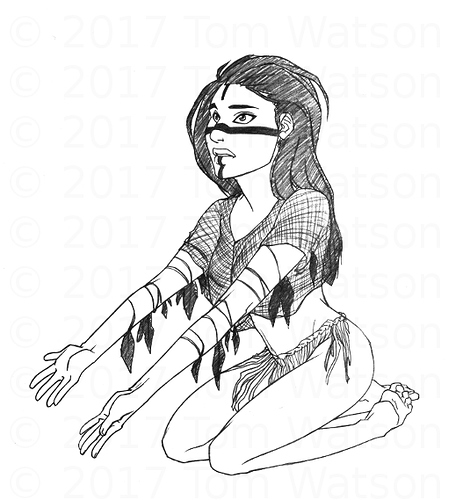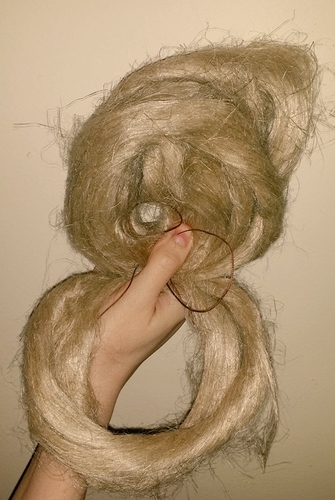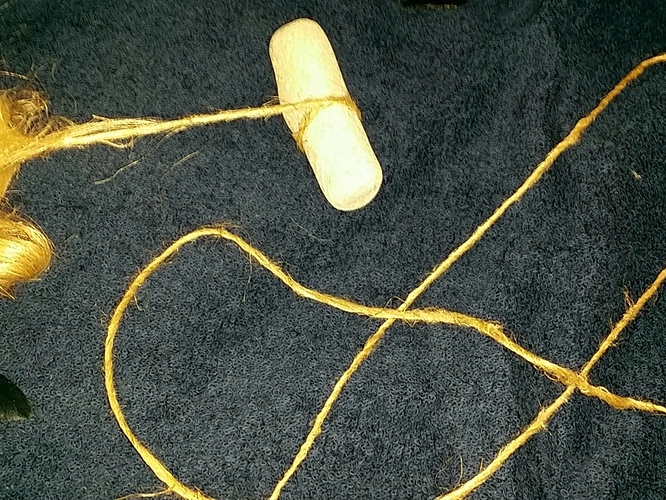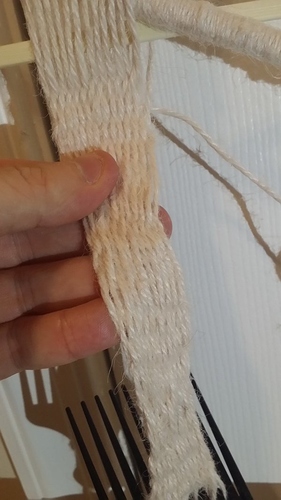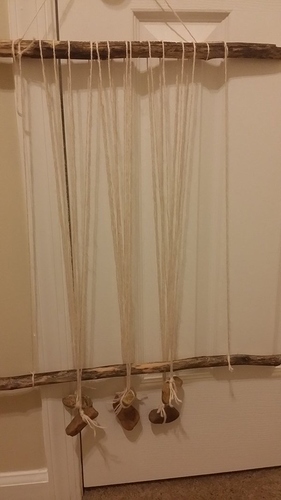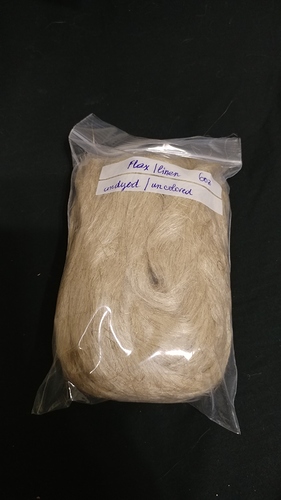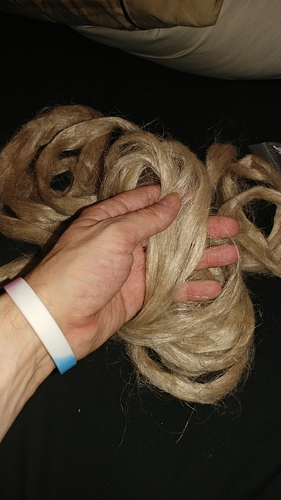I wanted to create a simplified breakdown of early Neolithic flax farming and cultivation without going into extreme academic detail. Much of what I write here comes from many different books I have read over the years as well as direct observation and flax fields I have visited, as well as my own personal experience with flax. As a result, I don’t have significant citations for each activity as I have probably performed many of them by hand, myself. If needed, I can find academic papers covering any component I mentioned.
I provided a narrative with a little story below each task to allow the reader, you, to experience the Neolithic world through the eyes of the people performing the tasks. They speak a recreated (imagined) Neolithic language I created. The scenes occur in Neolithic Germany near the Rhine, c. 5500BCE. Consider this a little gravy upon otherwise dry, academic meat. ![]()
The woman pictured is Anatolian, not Neolithic German. However, she is from the same time. And she is wearing a flax knitted shawl and flax string skirt.
Sowing / Growing – Flax should be planted in a field which has previously grown wheat or a similar crop. The seeds would be hand cast by workers, probably in a haphazard manner. Plants grown closely together make better flax to work with, having fewer spread out branches. Planted in the spring (date of planting changes a little by location), over the next 100 or so days, the flax will grow.
Aneha stood barefoot on the cool dirt taking a quick break. She wore a leather deer hide tied around her waist by a two ply braided flax cord. Though she might remove it when it became warmer during the midday, she had started off with a rabbit fur cape, made from several sewn furs by her aunt. Around her neck, a leather corded strap held a leather bag sewn with decorative shells, at her waist. Within the bag, flax seeds lay ready to scatter.
Resuming her work, she stepped forward with a handful of seeds, carefully releasing only a small number of them at a time in a sideways scattering pattern, left to right. Competing virtues, scattering the seed’s wide made work easier and used fewer seeds while keeping them tightly scattered would cause the plants to grow less broadly, producing better fibers. Farming was as much of an art form is a technical application of skill, as far as she was concerned.
Harvesting – Flax is harvested about 100 days after planting when yellowing of the upper leaves and pods can be seen. Workers would pull the flax from the ground, holding the base of the plant (pull from the base). The plants can be bundled, a single plant used to bound them. Flax would be left for a few days to dry.
“Eleh Aneha! Ehsu’eleh de tuh!” Malik exclaimed as he stepped into the flax field a little over three tendays since planting. His breechcloth chafed his skin in the heat of the mid-warm season, but a cool morning breeze helped a little. Before him, Aneha and three other women danced in the center of the field wearing wheat stalk wreaths and painted from head to toe in red orche, while two men beat drums singing the rituals to ensure a good harvest.
Malik bent forwards grasping a flax plant where it entered the dirt with his left hand, holding the upper portion of the plant with his right hand. Using a firm but gentle tug, he removed the plant from the ground and tossed it into the pile before him. His back hurt from bending over, but he knew the soft feel of his linen leggings this coming cold season had come from the cloth woven from the very sort work he did now. He could almost taste the coriander seasoning his people would trade flax and linen to obtain, as well as other goods. He hoped a trader would come by. Above all, he hoped Aneha appreciated his compliment and remembered that he had said it.
Rippling – Flax is passed through a comb-like object to strip the seeds. The complexity of combs both strong enough and dense enough to be quickly effective varied by location and likely many different forms of “comb” were used.
Meneh set on a leather mat outside of her wooden longhouse carefully holding a long polished wooden log between her legs, teeth of a comb carved into it. Grasping yet another bundle of flax from the fields, she held it by its base and carefully pulled it through the “comb” over and over, removing the seeds. The large pile of seeds and other material would be collected by her younger daughter to thresh and then winnow, but this was a separate process she need not worry about. It was possible to remove the seeds my hand, but the skin quickly became disagreeable making the comb of great use.
A smaller bone or wooden comb could be used, but most used the larger wooden combs to increase the speed of the process. After all, there were many other chores to be done. As she watched, her daughter Aneha wandered by with a large bundle of flax over her shoulder heading to the retting pond. The smile on her face told Meneh that she and that boy, Malik, remained on agreeable terms. She had seen them talking with one another earlier as they gathered flax from the other women rippling.
Retting – The outer plant material of the flax is allowed to rot and decay, separating it from the inner fibers. This can be done several ways, from leaving in a field to collect dew to placing in pond, weighted down by rocks, for a week or two.
About ten people stood in the retting pond arranging flax in wide, net like structures, plants crisscrossing other plants. This maximized the water’s access to the fiber while the crisscrossing nature of the arranged plants allowed them to all be easily held down with the fewest number of rocks. Like everyone else, Aneha wore only upper body paint while standing in the retting pond. There was no reason to destroy clothing with water, and the lower body would not remain painted anyway. She wore a white clay against the sun’s rays. Retting ponds had a less than pleasant odor, but they were the coolest job to be had in the early warm season. Some women even carried their nursing children, held against their chests using leather satchels.
Watching the men off in the distance attempting to remove as many stumps as they could from a new field being built reminded her of how lucky she was for retting duty. Among the men, she could see Malik hacking away at a stump with a stone ax. Soon, they would light fire to the stump, burning it away. Aneha dug around the water for a few moments until she found one of the large stones left from previous harvests, pulling it from the water than placing on top of the large netted mass of flax she had just finished laying. Without the wide, flat rock, the flax would rise too far out of the water and some of it would not properly ret, making later processing much more laborious. She would stop in a short time and join several of the other women chanting in the center of the retting pond. They would make a small offering of unleavened bread and honey to ensure the spirits of the pond helped them produce the finest quality flax. Rituals at every occasion were required to ensure the spirits did not object to their activities, causing them troubles.
Drying – Flax is allowed to dry in an open area for several days or weeks, based on the climate. The flax needs to be flipped every few days and monitored. Rocks can be placed over it to ensure the flax isn’t blown around by the wind.
Kepr leaned against a tree with a stick in his hand, thoroughly bored. Having seen ten harvests, he was hardly a man, yet. Though he knew he would become a mighty hunter, feared by all, right now his job was to stand between the old flax fields ensuring the winds didn’t blow away the drying stalks. Behind him, several men sat working to make straight wooden shafts from reasonably straight wooden sticks. Younger children would collect feathers and deliver them to Old Woman Yurn, considered by many to be the best fletcher in the village. She would carefully chew sinew and fletched each arrow the men made. Between watching the flax dry and watching the arrows made, Kepr suspected he had the most boring job in the entire village.
Breaking – The flax is placed in a bundle and beaten with wooden clubs to break the stalks, making removal of the inner bast fibers much easier.
Aneha sang a song to the beat of the breaking mallet. She and four other women sat around flat-topped, split wooden logs with wooden mallets in their hands breaking the flax fibers by literally pounding away at them. The wooden impact sounds of the mallets occurred in time, creating a beat. For a short time, a single woman would sing, and then another would take up the song with a slight variation. They laughed as each added a funny variation to her portion of the song. The men did the same thing with their tasks. Nearby, several children played with small wooden spears using a crudely made animal-like bundle of straw as a target. She smiled, knowing that one day the children would grow strong enough to do that same activity with a real animal and make their families proud. For now, she listened as the next person’s song began to the beat of the breaking mallet, thinking of how she might include Malik in her song without the other women realizing whom she spoke.
Scutching – Flat, smoothed wooden tools, resembling a butcher’s cleaver, are struck against the flax, nearly parallel to the fibers, but at perhaps a 20-degree angle. The outer plant fiber is easily removed leaving the long, soft bast fibers behind. After many strikes of the scutcher, the fibers are left in a bundle whilst the rotted plant fiber lays on the ground.
Malik knelt on a soft leather mat with a log before him, one side of it cut flat at an angle. He draped a fresh bundle of broken flax fibers over the edge, horizontally, and began beating them with a scutching blade. The wooden tool had a flat, blade-like end instead of being a beating club. Each swing of the wood bit into the flax tearing of the rotted plant material from the delicate flax fibers contained within. Wearing a pair of leather leggings and leather loincloth had been a bad choice given the humidity, but Malik didn’t like the feel of flax chaff sticking to his sweaty legs, and so the leggings had been a must.
As she slowly rotated the bundle, beating continuously, what looked like broken, rotted straw quickly turned into a beautiful fibrous bundle of hair-like material. There was something satisfying to him about watching the final product appear before his eyes. As he looked up, he took note of Aneha sitting on a leather mat about eight lengths of a man from him, hackling her flax, the next step after one was done scutching. He had almost worked his nerve up to speak to her and watching her flash him a smile now and then did little to weaken his resolve.
Hackling – The scutched flax can be simply spun into smaller threads, but ensuring uniformity of direction makes it easier to spin longer, continuous yarns. The flax is passed through a comb, similarly to rippling. Longer and shorter strands can be separated. Combs could be made from wood or bone.
Aneha wasn’t quite sure if she had caught Malik glancing her, though she hoped that she had. She sat on a leather mat holding long bundles of flax fiber and carefully pulling them through a thick bone comb. While technically not a required step for the flax that she now had, as it was of lesser quality and would probably be used to make small, short strings, it was a definite must for better quality flax, used to make clothing. The best quality flax would be very well hackled and made into bowstrings. Looking up, she caught Malik glancing at her once more.
She had worn her best quality red-deer wrap and a pair of leather sandals, as well as a flax cord necklace with polished aurochs teeth. She had even gone so far as to paint her entire upper body was twice-burned bone and wood ash, yet he had said nothing, yet. She had spent a lot of extra time that morning being painted by her younger sister, and she hoped it would pay off. If he didn’t come over and say something soon, she was going to have to take matters into her own hands.
Spinning – Flax fibers can be hand spun by simply pulling a little of the flax by hand, wetting your fingers first, and twisting the resulting cord. The spinner must be careful to pull flax slowly, continuously rolling the string at a constant but manageable speed. Too fast, and the string might break, being too thin. Too slow, and the string becomes too thick and does not twist well. The string may be rolled across a leg or attached to a weight that spins.
_Aneha licked her fingers and pulled at the large bundle of flax fiber, pulling a little bit of the fibers into the already spun string, a continuous operation producing a continuous length of yarn. She rolled the string against her leg until it was tight and pulled a little bit more flax. She could produce the length of her arm in the time it took her to count to ten. Her fingers hurt from a day spent spinning, but at least the weather had cooled. Her soft mink skin leggings and extra well-beaten doeskin breechcloth kept her lower body warm, while a doeskin shirt kept her upper body warm. Her feet were protected by simple leather wrap shoes, the kind people wore around the village. They were not good enough for long-distance hunting, but they were fine for the relatively well-packed ground the long houses were built on. _
Licking her fingers once more, she began pulling a little bit more flax when suddenly the string broke. She dropped the flax and the string and took a deep breath. Perhaps that was enough for today. Her thoughts were interrupted by the sound of someone asking her a question, both a voice and a question she found most welcome. She was glad it had finally happened before she had been forced to do it, herself.
“Aneha, eag khum de’aipku?” Malik asked her in a tentative, almost shy voice. Looking up from her spinning, she found Malik looking down at her with a smile on his face. Wearing a pair of thick leather leggings and heavy boots, with a long leather breechcloth and a heavy belt, Malik had been out in the wilds hunting. Across his back, he carried a quiver with several well-fletched arrows and an unstrung bow attached to the side. One never left a bow strung when it wasn’t in use. His upper body had been painted in black and white thatched patterns, obviously to please the forest spirits. Angry forest spirits were known to interfere with hunts, causing a wasted day.
Malik had just invited her to stand with him during the upcoming fertility festival during the withering season. She had decided that very morning that if he didn’t finally stand up and ask her to join him, she was going to do it herself. Luckily, he had asked her before she had been forced to take matters into her own hands, a much more desirable outcome in her opinion. Leaving the flax yarn and fibers on the ground to work on later, Aneha stood with a smile. Her hands hurt anyway, and perhaps the two could go for a walk and talk about things to come.
Weaving – Two ply flax yarn can simply be tied to a central belt, the hanging strands producing a simple flax string skirt, or used as a bow string, if well spun. Sometimes, however, more complex panels of cloth are required for clothing. For this, a weighted loom may be used. (A separate and lengthy explanation)
The cold season was coming as Malik and Aneha sat within their longhouse, a harvest and a half later. A wooden frame held strings running vertically and weighted by rocks tied at their base. Aneha slowly meandered a flax string through each of the vertical hanging strings making a crisscross shape which would eventually become a panel of cloth. She had heard that other tribes had more advanced techniques, but she wasn’t sure if the trader who had deposited that story knew what he was talking about. He had an untrusting face, in her opinion.
Her stomach protruded before her, a child within. Inside the family home, she had removed her shoes and her long leather shirt exposing the magically painted markings on her stomach which brought good luck for the coming child. A simple leather wrap would suffice within the warm longhouse. Behind her, Malik worked hard carving a new bone comb to be used in making flax during the coming seasons. The production of tools and materials never ceased, but neither did the cycle of life.
Boertien, J. H. (2013). Unravelling the fabric: Textile production in Iron Age Transjordan [S.l.]: s.n. Accessed online July 26, 2017 at www.rug.nl/research/portal/files/33262765/volledigedissertatie.pdf

